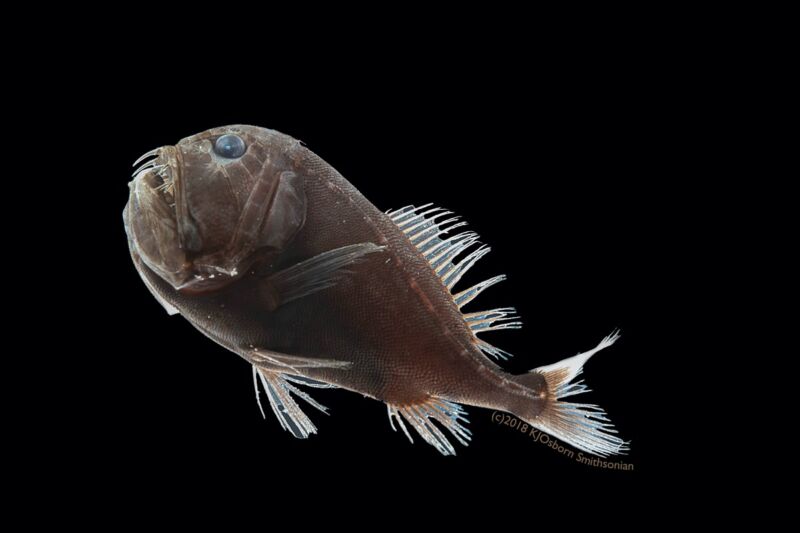
In the darkest depths of the ocean, where little to no light from the surface penetrates, an unusual array of creatures thrives, many of which create their own light via bioluminescence to hunt for prey, among other uses. But there are also several species of fish that have evolved the opposite survival strategy: they are ultra-black, absorbing nearly all light that strikes their skin, according to a new paper in Current Biology.
Karen Osborn of the Smithsonian's Museum of Natural History became intrigued by the creatures upon finding she was unable to capture these ultrablack fish on camera while working in the field, trying to photograph specimens caught in the team's deep-sea trawl nets. "Two specimens, the Anoplogaster cornuta and the Idiacanthus antrostomus, were the only two fish over the course of six years of field work that I was able to get decent photographs of," Osborn told Ars.
To do so, she used a Canon Mark II DSL R body and 65 mm macro lens with four strobes, then tested various lighting setups by taking lots and lots of photographs. Finally, she adjusted contrast and applied a high pass filter uniformly across the images, the better to bring out the details. It still wasn't sufficient to capture most of the specimens caught in the trawl net. "Over the years I deleted thousands of failed shots of other fish as useless because I couldn’t bring out the details in the photos," she added. "It didn't matter how you set up the camera or lighting—they just sucked up all the light. I wish I had a few of them now to illustrate this."
To discover why this was the case, Osborn teamed up with Duke University biologist Sönke Johnsen, among others, and laboratory measurements showed that, indeed, these ultra-black fish absorbed more than 99.5 percent of any light that hit their skin. That is a handy adaptation for survival in the dark depths of the sea, where even a few photons of light—say, from hungry nearby bioluminescent organisms—can give away a fish's position to a predator.
-
Another angle on the ultra-black fish species Anoplogaster cornuta.Karen Osborn/Smithsonian
-
This Anoplogaster cornuta fish was so lively after being sampled and documented that the research team released it back to the deep via submarine the day after being caught in a trawl net.Karen Osborn/Smithsonian
-
The ultra-black Pacific blackdragon (Idiacanthus antrostomus), the second-blackest fish studied by the research team.Karen Osborn/Smithsonian
-
The Pacific black dragon has a bioluminescent lure that they use to attract prey, and if not for their ultra-black skin and transparent, anti-reflective teeth, the reflection of their lure would scare prey away.Karen Osborn/Smithsonian
-
The Pacific blackdragon also has light-producing organs below their eyes that scientists expect might be used as a searchlight to spot prey.Karen Osborn/Smithsonian
-
The ultra-black ridgehead (Poromitra crassiceps). These fish are also commonly known as bigscales because of the few giant scales they possess. Their ultra-black skin covers their scales, but the skin and scales detach easily when a predator tries to grab them.Karen Osborn/Smithsonian
The researchers also discovered the secret to this highly efficient light absorption: melanin, a pigment also found in human skin that protects us from damage from sunlight. The melanin is stuffed into granules known as melanosomes, which in turn are contained within cells known as melanophores. They form a continuous layer in the dermis (the deeper layers of skin), according to Osborn. "This arrangement provides a continuous and unbroken layer of pigment-containing cells and ensures that this layer is the first thing encountered by light hitting the fish," she said. "The pigment effectively absorbs most of the light that strikes the granule."
The size and shape of those granules also matters, since they scatter any light that isn't immediately absorbed sideways into the pigment layer so it can be absorbed by neighboring pigment-containing cells. It's essentially a very thin, highly efficient light trap. "The blackest fish was as black as VantaBlack," said Osborn—that is, as black as one of the darkest substances yet known. "VantaBlack traps light in tightly packed carbon microtubules while these fish absorb the light with the pigment and do it extremely efficiently by optimizing the size and shape and packing of the pigment granules themselves."
"In pretty much all ultra-black materials you need both scattering and absorption," said co-author Alexander Davis, a graduate student at Duke. "In all other animals that we know of, the scattering in ultra-black coloration comes from either a chitin or keratin matrix, like a bird feather or butterfly scale, and the absorption comes from melanin embedded within those matrices. In these fishes, the scattering and absorption are both coming from the melanosomes themselves. This makes the mechanism a bit simpler because there is no structural scaffold necessary."
Several ultra-black species seem to have independently evolved the exact same adaptation; Osborn and her colleagues found these pigment patterns in 16 distantly related species. The eventual goal of the research is to adopt a similarly efficient design to make ultra-black materials—such as interior coatings for telescopes, cameras, and other light-sensitive equipment—much more cheaply and easily.
DOI: Current Biology, 2020. 10.1016/j.cub.2020.06.044 (About DOIs).
"fish" - Google News
July 18, 2020 at 09:00PM
https://ift.tt/3hcuGtR
Scientists unlocked the secret of how these ultra-black fish absorb light - Ars Technica
"fish" - Google News
https://ift.tt/35JkYuc
https://ift.tt/3feFffJ
Bagikan Berita Ini
















0 Response to "Scientists unlocked the secret of how these ultra-black fish absorb light - Ars Technica"
Post a Comment